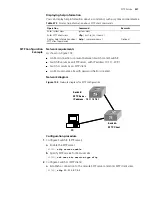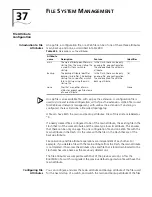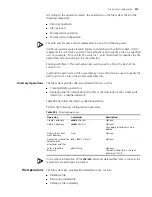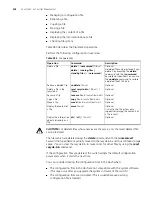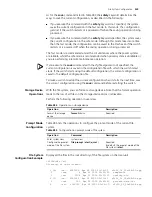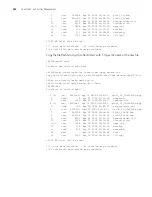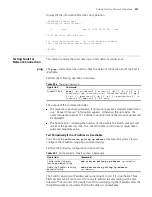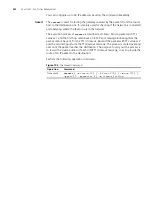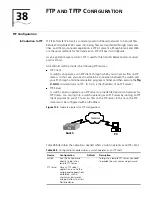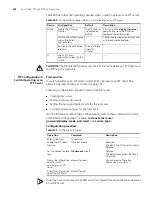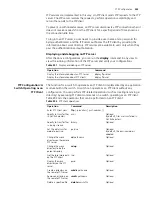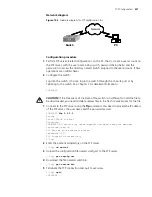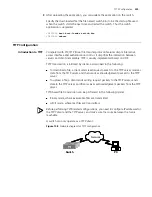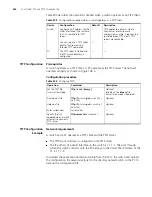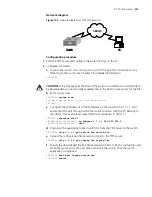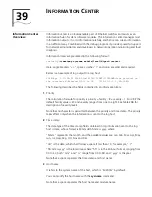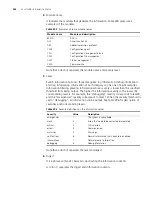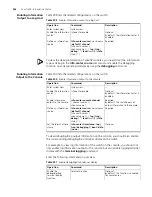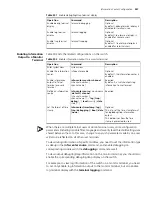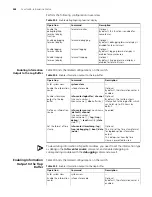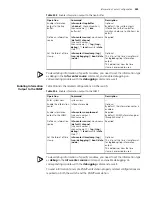
334
C
HAPTER
38: FTP
AND
TFTP C
ONFIGURATION
Table 289 describes the operations needed when a switch operates as an FTP server.
CAUTION:
The FTP-related functions require that the route between a FTP client and
the FTP server is reachable.
FTP Configuration: A
Switch Operating as an
FTP Server
Prerequisites
A switch operates as an FTP server. A remote PC operates as an FTP client. The
network operates properly, as shown in Figure 105
Following configurations are performed on the FTP server:
■
Creating local users
■
Setting local user passwords
■
Setting the password display mode for the local user
■
Configuring service types for the local users
(For the information about these configurations, refer to these commands in “AAA
and RADIUS Configuration” module:
local-user
,
local-user
password-display-mode
,
password
,
and
service
-
type
.)
Configuration procedure
Only one user can access an S4200G switch at a given time when the latter operates
as an FTP server.
Table 289
Configurations needed when a switch operates as an FTP server
Device
Configuration
Default
Description
Switch
Enable the FTP server
function
The FTP function
is disabled by
default
You can run the
display
ftp-server
command to view the FTP server
configuration on the switch.
Perform the authentication
and authorization
configurations
—
Configure user names, passwords and
authorized work directories.
Configure the connection
idle time
The default idle
time is 30
minutes.
—
PC
Use an FTP client
application to log into the
switch.
—
—
Table 290
Configure an FTP server
Operation
Command
Description
Enter system view
system-view
—
Enable the FTP server
function
ftp server enable
Required
By default, the FTP server function is
disabled.
Set the connection idle
time
ftp
timeout
minute
Optional
The default connection idle time is
30 minutes.
Display the information
about a switch
operating as an FTP
server
display ftp-server
You can execute these two
commands in any view.
Display the information
about the FTP clients
display ftp-user
Summary of Contents for 4200G 12-Port
Page 10: ...8 CONTENTS...
Page 14: ...4 ABOUT THIS GUIDE...
Page 46: ...32 CHAPTER 5 LOGGING IN THROUGH WEB BASED NETWORK MANAGEMENT SYSTEM...
Page 48: ...34 CHAPTER 6 LOGGING IN THROUGH NMS...
Page 60: ...46 CHAPTER 9 VLAN CONFIGURATION...
Page 64: ...50 CHAPTER 10 MANAGEMENT VLAN CONFIGURATION...
Page 80: ...66 CHAPTER 13 GVRP CONFIGURATION...
Page 98: ...84 CHAPTER 15 LINK AGGREGATION CONFIGURATION...
Page 112: ...98 CHAPTER 18 MAC ADDRESS TABLE MANAGEMENT...
Page 126: ...112 CHAPTER 19 LOGGING IN THROUGH TELNET...
Page 162: ...148 CHAPTER 20 MSTP CONFIGURATION...
Page 274: ...260 CHAPTER 29 IGMP SNOOPING CONFIGURATION...
Page 276: ...262 CHAPTER 30 ROUTING PORT JOIN TO MULTICAST GROUP CONFIGURATION...
Page 298: ...284 CHAPTER 33 SNMP CONFIGURATION...
Page 304: ...290 CHAPTER 34 RMON CONFIGURATION...
Page 338: ...324 CHAPTER 36 SSH TERMINAL SERVICES...
Page 356: ...342 CHAPTER 38 FTP AND TFTP CONFIGURATION...
Page 365: ...Information Center Configuration Example 351 S4200G terminal logging...
Page 366: ...352 CHAPTER 39 INFORMATION CENTER...
Page 378: ...364 CHAPTER 40 BOOTROM AND HOST SOFTWARE LOADING...
Page 384: ...370 CHAPTER 41 Basic System Configuration and Debugging...
Page 388: ...374 CHAPTER 43 NETWORK CONNECTIVITY TEST...
Page 406: ...392 CHAPTER 45 CONFIGURATION OF NEWLY ADDED CLUSTER FUNCTIONS...


